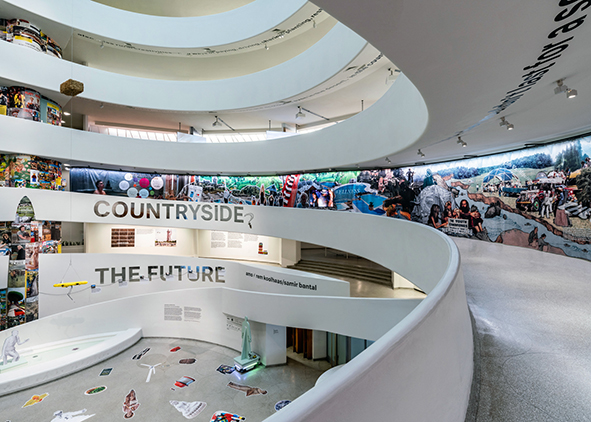The territory into architecture. Big scale and agriculture in Italian Architecture, 1966-1978
DOI:
https://doi.org/10.19229/2464-9309/752020Keywords:
Vittorio Gregotti, Aldo Rossi, Archizoom, Superstudio, 9999Abstract
An unprecedented inter-scalarity links Italian Architecture to the notion of territory between 1966 and 1978. Two main strands are shown as theoretical foundations of some contemporary orientations of the discipline. The first refers to Vittorio Gregotti and Aldo Rossi, the second to the Radical Avant-garde. The teaching of the territory concerning the modalities of relationship between formal facts and the autonomous role of architecture in the historical city, seen in parallel with the fictional projects of the Radical Architecture and the role that agriculture plays there, shows that trans-scalarity is here inseparable from trans-disciplinarity. Those works, distilling the formal gesture to reactivate large-scale relationships in a diachronic time, by opposing architecture to the artificiality of the consumerist city on its way to conquest every land, using the collage in a poetics for fragments, and composing projects as scenarios, still echo in our season.
Downloads
Article Metrics Graph
References
(1972), “Group 9999”, in Ambasz, E. (ed.), Italy – The New Domestic Landscape – Achievements and Problems of Italian Design, Museum of Modern Art, New York, pp. 276-281. [Online] Available at: www.moma.org/documents/moma_catalogue_1783_300062429.pdf [Accessed 21 March 2020].
Archizoom Associati (1970), “Città, catena di montaggio del sociale. Ideologia e teoria della metropoli”, in Casabella, n. 350-351, pp. 43-52. [Online] Available at: arena-attachments.s3.amazonaws.com/1494979/ d84270a342af9ecbbd61dd4520c59e18.pdf?1512842788 [Accessed 21 March 2020].
Aureli, P. V. (2016), Il progetto dell'autonomia – Politica e architettura dentro e contro il capitalismo [or. ed. The Project of Autonomy – Politics and Architecture within and against Capitalism, 2008], Quodlibet, Macerata.
Banham, R. (1959), “Neoliberty. The Italian Retreat from modern architecture”, in Architectural Review, n. 747, pp. 231-235. [Online] Available at: misfitsarchitecture.com/wp-content/uploads/2015/07/reyner-banham_neoliberty-the-italian-retreat-from-modern-architecture-the-architectural-review-ar-125-april-1959-pp-230-235.pdf [Accessed 21 March 2020].
Battisti, E. and Crotti, S. (1965), “Note sulla lettura del paesaggio antropogeografico”, in Edilizia Moderna, n. 87-88, pp. 53-59.
Branzi, A. (1973), “Rock e Rivoluzione – Radical Notes n. 5”, in Casabella, n. 374, p. 10.
Calabi, D. (1997), Parigi anni Venti – Marcel Poëte e le origini della storia urbana, Marsilio, Venezia.
Celant, G. (1972), “Radical architectures”, in Ambasz, E. (ed.), Italy – The New Domestic Landscape – Achievements and Problems of Italian Design, Museum of Modern Art, New York, pp. 380-387. [Online] Available at: www.moma.org/documents/moma_catalogue_1783_300062429.pdf [Accessed 21 March 2020].
Critchley, M. (2016), Continuity or Crisis – A brief history between the polemics of Aldo Rossi and Reyner Banham. [Online] Available at: www.aaschool.ac.uk/Downloads/WritingPrize/2013Shortlist/ MatthewCritchley.pdf [Accessed 21 March 2020].
Gregotti, V. (1966), Il territorio dell’architettura, Feltrinelli, Milano.
Gregotti, V. (ed.) (1965), “La forma del Territorio”, in Edilizia Moderna n. 87-88.
Lopez, F. (2014), Le Rêve d’une déconnexion – De la maison autonome à la cité auto-énérgétique, Editions de La Villette, Paris.
Mastrigli, G. (ed.) (2016), Superstudio – Opere 1966-1978, Quodlibet, Macerata.
Navoni, P. and Orlandoni, B. (1974), Architettura Radicale, Documenti di Casabella, Milano.
Poëte, M. (1929), Introduction à l’urbanisme – L’évolution des villes, Boivin, Parigi.
Rossi, A. (2012), Scritti scelti sull’architettura e la città – 1956-1972, Quodlibet, Macerata.
Rossi, A. (2011), L’architettura della città [or. ed. The Architecture of the City, 1966], Quodlibet, Macerata.
Rossi, A. (1964), “Considerazioni sulla morfologia urbana e la tipologia edilizia”, in Aymonino, C. et alii, Aspetti e problemi della tipologia edilizia, CLUVA, Venezia, pp. 15-32.
Rossi, A. (1958), “Il passato e il presente nella nuova architettura”, in Casabella Continuità, n. 215, p. 16.
Rouillard, D. (2004), Superarchitecture – Le futur de l’architecture 1950-1970, Editions de la Villette, Paris.
Scolari, M. (1973), “Avanguardia e nuova architettura”, in Architettura Razionale – XV Triennale di Milano – Sezione Internazionale di Architettura, FrancoAngeli, Milano, pp. 153-187.
Tafuri, M. (1987), La sfera e il labirinto – Avanguardie e architettura da Piranesi agli anni ’70, Einaudi, Torino.
Tafuri, M. (1974), “L’architecture dans le boudoir – The language of criticism ant the criticism of language”, in Oppositions, n. 3, pp. 37-62. [Online] Available at: monoskop.org/images/8/8d/Tafuri_Manfredo_1974_L_ Architecture_dans_le_Boudoir_The_Language_of_Criticism_and_the_ Criticism_of_Language.pdf [Accessed 21 March 2020].

Downloads
Published
How to Cite
Issue
Section
License
This Journal is published under Creative Commons Attribution Licence 4.0 (CC-BY).
License scheme | Legal code
This License allows anyone to:
Share: copy and redistribute the material in any medium or format.
Adapt: remix, transform, and build upon the material for any purpose, even commercially.
Under the following terms
Attribution: Users must give appropriate credit, provide a link to the license, and indicate if changes were made; users may do so in any reasonable manner, but not in any way that suggests the licensor endorses them or their use.
No additional restrictions: Users may not apply legal terms or technological measures that legally restrict others from doing anything the license permits.
Notices
Users do not have to comply with the license for elements of the material in the public domain or where your use is permitted by an applicable exception or limitation.
No warranties are given. The license may not give users all of the permissions necessary for their intended use. For example, other rights such as publicity, privacy, or moral rights may limit how you use the material.


















































































